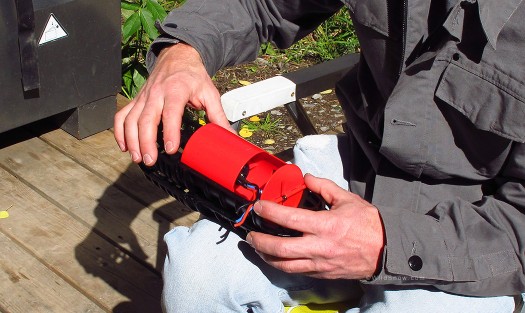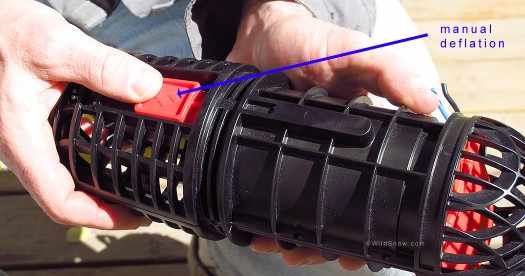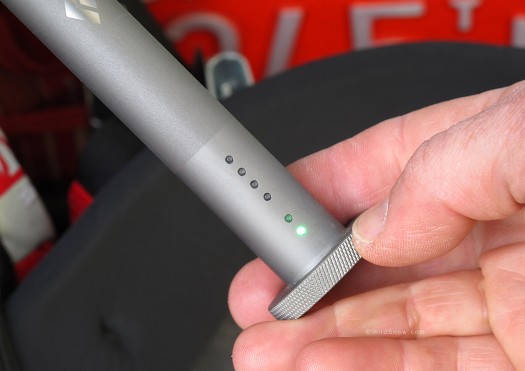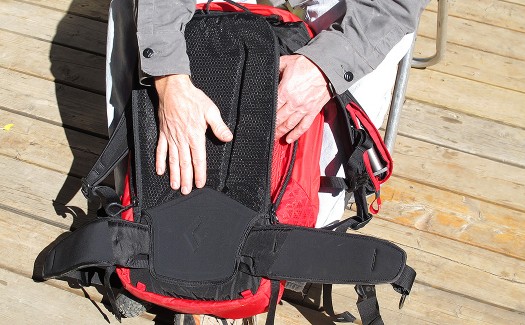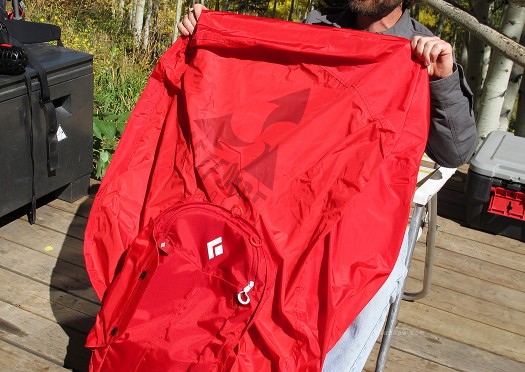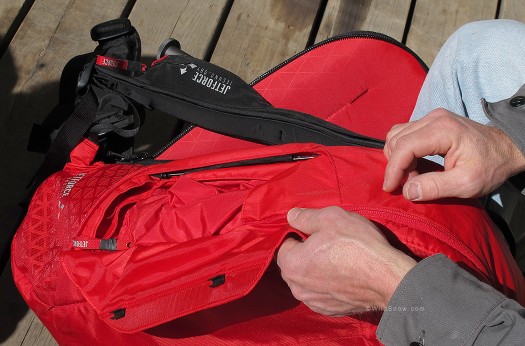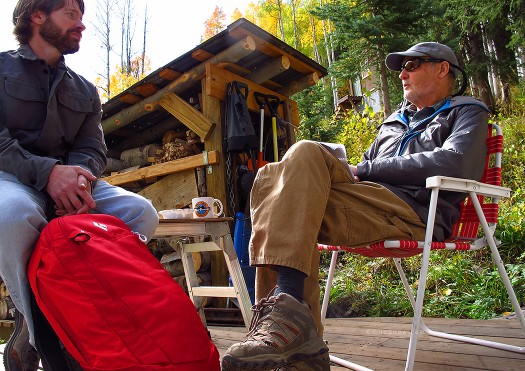
Lou (right) meeting with Black Diamond's Nathan Kuder. They call their battery operated airbag design (at lower left)'Jetforce' We are so interested in this technology we've been publishing every teaser possible. This post is the real deal -- our in-person close look at that appears to be a retail ready product. Click all images to enlarge.
In Nathan’s words: “Production weight will probably be about 7 pounds 4 ounces — the lighter or at least average side of the equation for airbag backpacks in the 30 liter range. While weight is important, our primary goal with this product is to make it as safe as possible. To that end, some of this Jetforce version could be considered over-engineered and our first retail packs will probably be heavier than refined versions as the product progresses. One example of this is how we run the fan, with more air (and thus more battery power) than necessary to compensate for tears in the airbag fabric. We did consider a pressure sensor inside the bag that would control inflation. The pack doesn’t include that for now, though it could in the future. If you’re curious about where the backpack design came from (this one is the 28 liter Halo), it evolved from our Anthem model. All our airbag packs include the BD ReActiv suspension system, which allows the pack to adjust to your body movements and carry more easily.”
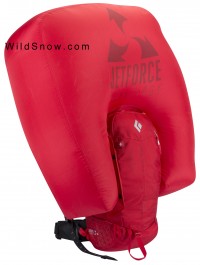
Halo 28 Jetforce airbag backpack. The pack will be available in 11, 28 and 40 liter capacity. Pieps will also sell some packs with Jetforce airbags, as will Poc.
Black Diamond’s “Jetforce Technology” airbag backpacks inflate in 3 seconds, with ambient air sourced from a battery and fan. The control firmware can be programmed to do just about anything. Pulse the fan, run in reverse, and so on. This was my second time going up close and personal with Jetforce, and I remain convinced that the system is viable and possibly the future in avalanche airbag technology. In other words, I’m not going to be surprised if compressed gas airbags are off the market within 24 months.
I asked Nathan about using UHMW (i.e., Dyneema) fabric for the bag, and how that would influence the necessity of battery power to compensate for tears. He said that indeed a “tear proof” airbag would be desirable, but adds quite a bit of cost so it was left out of the project for now. Nathan did allude to the fact that given various improvements, the battery could indeed be lighter — and that a Dyneema bag would be lighter as well, perhaps resulting in a significantly lighter backpack. We can dream, can we not?
The advantages:
– Easy air travel, little to no restrictions on the batteries as they’re no different than laptop batteries.
– As many practice deployments as you desire, battery good for one to six full inflations (depends on temperature and age), recharge it for more.
– NO hassle with compressed gas cylinders. No pumping, no exchanging, no nothing.
– With stock battery, may be slightly lighter in weight than compressed gas offerings, with smaller battery will be significantly lighter.
– Automatic deflation cycle can possibly create airspace around head in the event of burial.
– Specific to BD design, airbag stuff-stows loosely after use, pack it in minutes, no folding or other tangled origami.
– Fan is set to cycle on periodically during 3 minute inflation period per CE standards, this can overcome up to 7 inch tear in the fabric.
The disadvantages, in our opinion:
– Battery power significantly reduced when temperatures drop to single digits.
– Limited pack styles, appears to be mostly available in panel loaders.
– Lithium battery could be dangerous if damaged.
– Lithium battery deteriorates with age.
– Possible obstruction of air intakes.
– Still expensive.
– New technology that will doubtless undergo numerous improvements; do you want to be an early adopter?
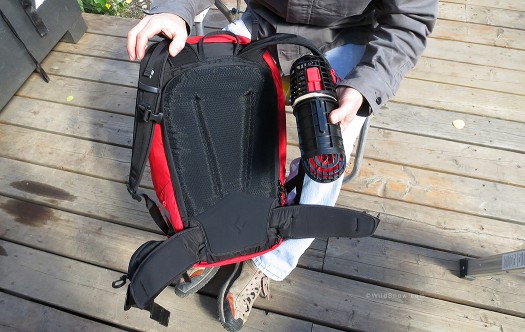
Halo 28 backpack we're detailing here is a panel loader, shown here with a sample of the internal fan enclosure. The back panel acts as a large part of the air intake, using the same type of foam as pre-filters on snowmobile air intakes. Total intake area on the Jetforce backpacks is said to be 3 square feet or more. Click images to enlarge.
One of the most valid concerns I’ve heard about Jetforce technology is clogging of the air intakes; unlike compressed gas based airbag, Jetforce depends on 100% ambient air. Fact of the matter is that snow contains a lot of available air — especially when falling in an avalanche and even after the avalanche stops. That’s why Avalungs function. More, even compressed gas airbags depend on a certain amount of ambient air they suck in through their venturi valve (essentially, they’re ‘powered’ by compressed gas instead of electricity). Thus, if you’re concerned about clogging of the Jetforce intake, you might want to ask why that’s not a concern with compressed gas nor with your Avalung. Granted, even if the compressed gas venturi is clogged the airbag will still inflate to some degree, but flotation will be compromised. In either case, good engineering and design should be able to prevent clogging of any snow/air system in all but the most dire circumstances.
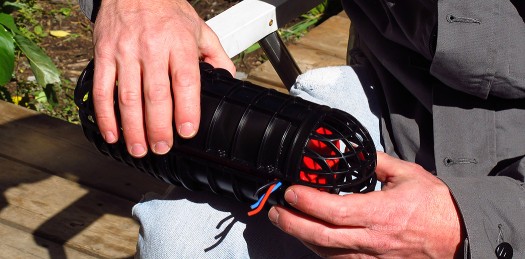
Gut of the Jetforce system is the ducted fan and housing. Shown here detached from pack. The airbag attaches to one end of the cage, cinched with a simple pressure strap. Airbag is also strongly attached to the backpack with a lacing system, of course.
I asked Nathan, “Why no Avalung?” “To avoid confusion,” he responded. “As in, ‘do I concentrate on getting this thing in my mouth, or pulling the airbag trigger?’ We didn’t want to appear to be creating some sort of ‘Swiss Army Knife’ of avalanche safety. The Avalung sling is available if you do want to use both devices, as it is true that in some situations, such a tree wells, the Avalung has the advantage.”
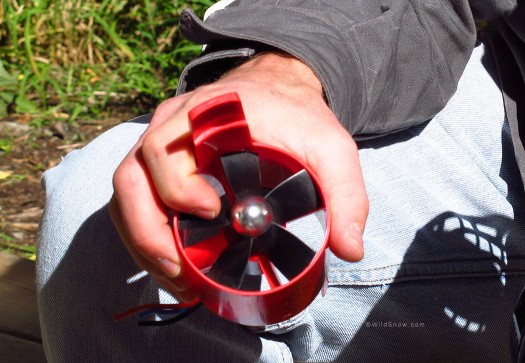
Ducted fan draws 60 amps at 28.8 volts and does make noise. Similar or same as used for model jets. Controlling this sort of electrical tech is a daunting goal. The serendipitous factor in all this is that as the Jetforce hardware developed, Black Diamond bought Pieps and thus got the electronics wizards at Pieps involved in designing the Jetforce fan control, trigger and so forth. During my hands-on evaluation, this really showed. Everything electronic in the Jetforce system has a very modern 'put together' look and feel. I have to laugh, because I'd bet you could make this system work by simply providing an on/off switch hooked to a pressure sensor. But why, when you've got a room full of electronics Einsteins at your disposal?
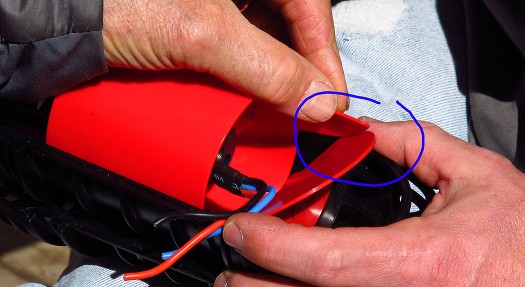
Inside the fan cage, the ducted fan has a 'fang' (circled) that opens the butterfly valve for deflation. You do manual deflation by simply pressing and sliding a trigger, as noted in the photo. But the automatic deflation feature should usually take care of emptying the bag, and actually 'vacuum' packs it to some degree!
When will Jetforce be retailed? “Innovation of this sort is a complex process,” said Nathan. “We’ll be showing the pack at Winter OR Show (January 2014), and we anticipate a late fall delivery date of approximately 11/2014. But we can’t confidently commit to a retail schedule until certification is complete. Right now, certification requirements are a moving target and until we know more it’s impossible for us to commit 100%. We will definitely be employing our advanced field testing protocol to continue beta testing this winter.”
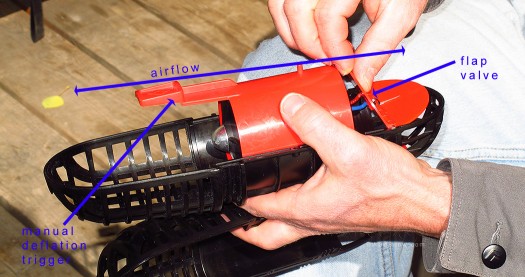
The fan is powerful. When reversed, it slides within the housing and presses the 'fang' against the butterfly valve thus opening it.
Fan timing is controlled by the electronics. At this point in the design, here is how it cycles:
0-9 secs: Mandatory Fill
During the first 3.5 seconds, the airbag fills 100%. For the next 5.5 seconds, the system continues to run at full speed for safety redundancy.10-60 secs: Active Performance
The system pulses between full speed and 50% speed. Since this is the most likely time to be carried by the avalanche, it is most critical to maintain full volume and recover from any possible tears.61-180 secs: Volume Maintenance
The system has 20s stand-by intervals between 3s full speed refilling pulses. The goal is to maintain the volume to aide in visibility and meet CE timing requirements.181 sec: Active Deflation
After 3 total minutes, the bag will automatically deflate. If partially or completely buried, this has the potential to create a large volume of air for breathing and/or extraction. If unburied, this simply helps repack the airbag quicker.
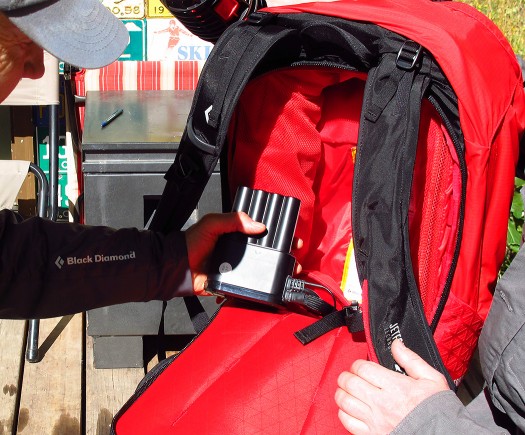
The battery and electronics case is hard-wired into the airbag backpack. Word is that due to Black Diamond and Pieps being associated (under same ownership), Pieps provided state-of-art electronics to do 'just about anything we wanted' in terms of fan control, indicator lights, etc.
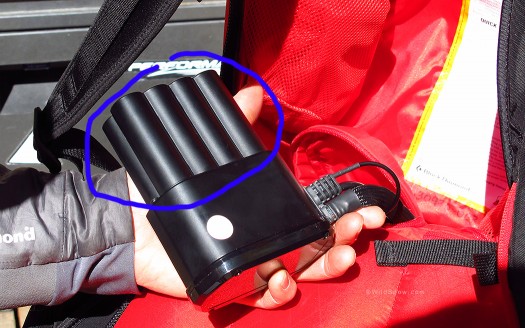
Battery is mated to the electronics (on top in this photo), attached with small screws. This could conceivably allow for a small and lighter battery with significant weight savings. Key point with this is that Black Diamond is sourcing a battery they say does up to 6 inflation cycles at room temperature, and reliably ONE at super cold temps. That means for the skier in mellow temperatures such as western Europe, coastal PNW and normal Colorado, a lighter weight battery could be a viable option. Indeed, the electronics could even include a warning chime hooked to a thermometer that sounded if battery temp was too low for reliability. As it is, I find it hard to believe that a warm lithium battery is SIX times more powerful than a cold one. My guess is BD is being very conservative with this issue.
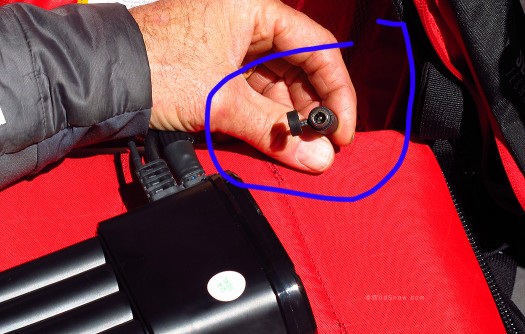
You charge the battery with a simple wall charger and barrel connector. All aspects (including charge connector) of the airbag system you'd need to work with are available without unpacking the pack.
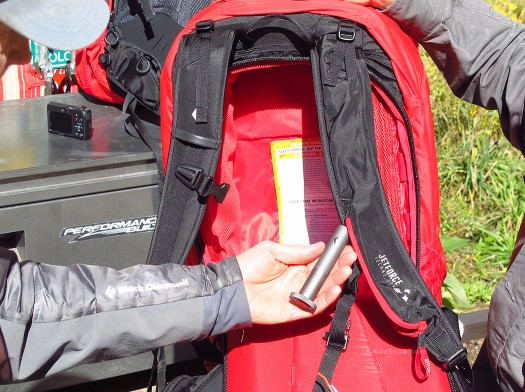
Trigger is intentionally NOT a T-grip, works right or left handed, with mittens or whatever. A series of small LCDs indicate on-off and other conditions. Red button at end of handle is the on-off switch. You press 4 seconds to 'arm' the system, resulting in a self-check that cycles the fan and flashes the lights. It's very easy to turn the system on and off, thus 'safing' it for things like aircraft travel. I'd prefer the battery to also be removable, but BD has good reasons for hardwiring it (reliability). Interestingly, trigger is both mechanical and electronic. The mechanical part consists of a cable that moves and releases a cover flap on the side of the pack to allow deployment of the airbag.
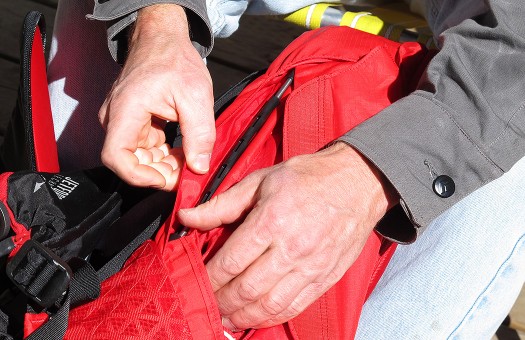
This flap on the side of the pack is where the airbag first deploys. It then parts a lightweight coil zipper. No velcro and no special zipper, both of which are known to be unreliable and come apart accidentally. Instead, when you pull the trigger a cable releases a couple of tiny catches that start the initial airbag deployment.
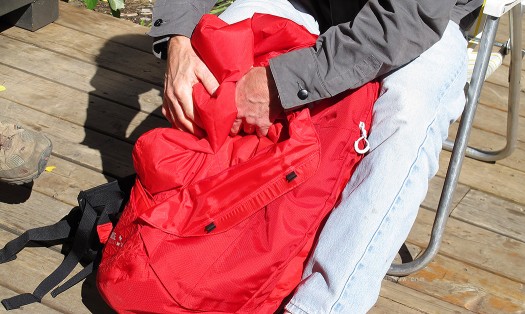
Best feature next to no compressed gas? Stuff the airbag in minutes, not folding or other tedious prep, no danger of improperly packed airbag failing to deploy.
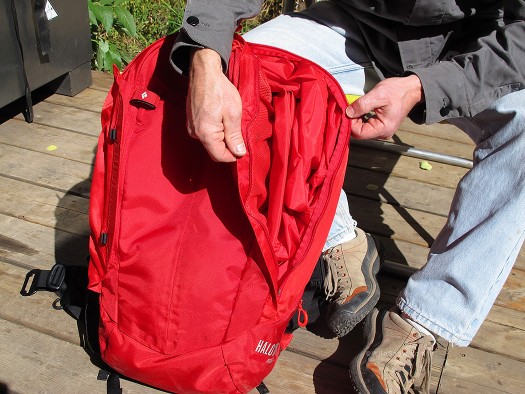
The side flap, showing the cable-actuated catch system. Easily opened without triggering inflation by pulling on a smaller diameter black plastic area on the cable above the trigger. Ease of removing and repacking airbag will encourage practice, drying after wet conditions, etc.
There you go. Rumors of this airbag backpack have circulated for several years. It appears the rumors have become reality at least in the prototypical sense. While we did not ski with the pack or test it in an avalanche, we did go through it extensively as well as deploying and packing the airbag. For a pre-retail proto, I was impressed by how highly designed everything appeared. It all looked like it could be retailed tomorrow, and that waiting another year could be considered ultra-conservative. As Nathan mentioned above, Black Diamond’s plan this winter is to have a limited number of beta testers, and begin shipping retail units in late fall or early winter of 2014. Nathan told me that the retail price will be around $1,000, which doesn’t surprise me.
Editorial note: We’ve stated numerous times that we’re uncomfortable covering products that may not be retailed for some time. Even so, when we’re allowed to cover an innovation such as Jetforce, due to how “disruptive” the product could be we feel it’s appropriate to preview it. That being said, always take pre-retail product details with a grain of salt. By the time the Jetforce backpacks are on store shelves they could be drastically different. Designers and engineers will make changes, and the European certification system is in constant flux. Main point is that the “fan” concept for an airbag backpack appears to be viable and coming on strong. Will there be one in your future?
Previous posts about fan based airbags:
Our take on Popular Science magazine coverage of Jetforce.
Arcteryx has a patent as well, we detail it here.
WildSnow.com publisher emeritus and founder Lou (Louis Dawson) has a 50+ years career in climbing, backcountry skiing and ski mountaineering. He was the first person in history to ski down all 54 Colorado 14,000-foot peaks, has authored numerous books about about backcountry skiing, and has skied from the summit of Denali in Alaska, North America’s highest mountain.

